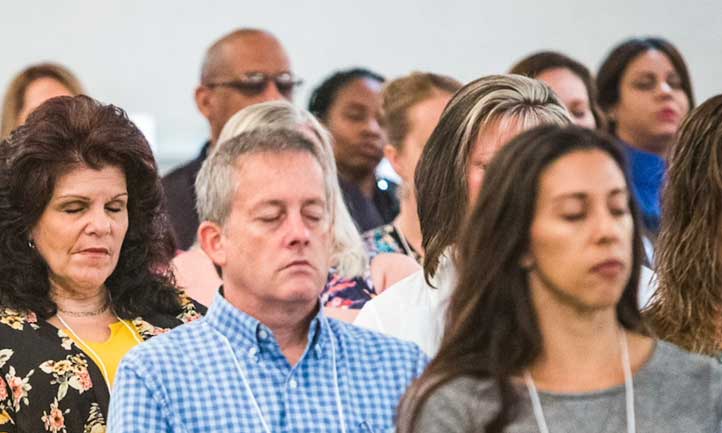Restoring Balance Amid Grief and the Pandemic
Author: James Gordon
Over this past year, pandemic-induced fear, grief, and uncertainty have compounded the pain of loss, while sound public health practice has kept us from the physical closeness that in other years helped assuage our loss and loneliness.
To move through our grief, we must first accept both past and recent loss. If we know that the pain that accompanies loss is normal and to be expected, we will be less devastated by it and far less inclined to think of ourselves as damaged as well as grieving. If we also resist the temptation to “tough it out,” an attitude common to many veterans and their families, we can more fully honor those whom we have lost and at the same time move more easily through grief’s inevitable pain.
We need to begin by quieting the anxious fight-or-flight state, which makes loss far more difficult to deal with, and restore the physical and psychological balance that will make it possible for us to successfully use tools of self-care and reach out comfortably to others for support.

Soft Belly Breathing
Soft Belly Breathing, a nondenominational, “concentrative” meditation which I teach at the beginning of “Transforming Trauma: The Path to Hope and Healing,”is the antidote to fight-or-flight and the foundational technique for moving through loss and loneliness. Soft Belly Breathing—sitting comfortably, breathing slowly and deeply, in through your nose and out through your mouth with your belly soft and relaxed—quiets activity in the amygdala, the center of the emotional brain responsible for fear and anger; Soft Belly Breathing also enhances activity in areas of the frontal cortex that maximize self-awareness, thoughtful decision making, and compassion.
As we breathe slowly and deeply, our bodies relax, our minds grow more quiet, and we gain perspective on what’s hurting and harming us. We begin to see that the grief which feels so overwhelming goes as well as comes, that it is part of, but not all of our lives. At the same time, areas of our brain come online that make it easier for us to connect with others who can provide emotional support. Three to four minutes, three or four times a day, is a beautiful way to restore our balance.
Shaking and Dancing
Physical activity is also a powerful tool for bringing us back in balance, enhancing our mood, and helping us move through grief. Often enough twenty or thirty minutes of stretching or walking brings us new energy as well as a feeling of ease, helps us feel more competent and confident as we deal with the pain of loss.
“Expressive” meditations, active physical techniques like fast, deep breathing, add another dimension to movement, breaking up fixed physical postures with which we protect ourselves against emotional hurt and bringing to the surface sadness, anger, and also joy that we may have resisted feeling.
The “expressive” meditation that I like to begin with is called “Shaking and Dancing.” It’s one my Center for Mind-Body Medicine colleagues and I have taught to thousands of veterans and their family members as well as to civilian populations traumatized by and grieving the losses of war, climate related disasters, school shootings, the opioid epidemic, and, most recently, the COVID-19 pandemic.
Shaking and Dancing may seem a little goofy at first, but it works.
Here’s how you do it.
First make a playlist. Begin with fast, driving, repetitive, rhythmic music for say five to eight minutes (I give some suggestions in “Transforming Trauma”). Then create a two-minute quiet space on your playlist. And then add music that inspires and energizes you. I like Reggae but you should select whatever feels right.
Now you’re ready to go.
Stand up. Put your feet shoulder width apart, bend your knees a little, and start shaking from your feet to your knees, hips, chest, shoulders, and head. Allow your whole body to shake. Do it as forcefully as you can. If there are other people with you and you don’t have any problems with balance, you may want to close your eyes so you are not distracted. Then, pause, relax and feel your breath and body. After two minutes, you’ll hear the inspiring music you selected. Just let your body move to it as it wants. As emotions arise, allow yourself to experience them. Afterwards, you are likely to feel a sense of release and freedom as well as more energy.
Reach out to others
Both Soft Belly Breathing and Shaking and Dancing help us feel easier in ourselves and make us feel more comfortable connecting with others. Take advantage of these experiences and reach out to whoever feels important to connect with. Trust your intuition. You may be happily surprised at your friends’ or family members’ pleasure.
This time of COVID enforced separation can actually help us to appreciate one another even more, to connect surprisingly deeply even when we are physically distanced. I would particularly encourage you to reach out to people in the TAPS community, who can appreciate the complexity and the richness of what you are going through, people who will be grateful and pleased to walk with you on your path of healing.
James S. Gordon, MD, a Harvard-trained psychiatrist and former National Institute of Mental Health researcher, is a Clinical Professor at Georgetown Medical School and was Chair of the White House Commission on Complementary and Alternative Medicine Policy under Presidents Clinton and G.W. Bush. He is the founder and executive director of The Center for Mind-Body Medicine (CMBM). You can learn much more about Soft Belly Breathing, Shaking and Dancing, and other practical, evidence-based techniques of self-care in his most recent book Transforming Trauma: The Path to Hope and Healing. Dr. Gordon is a TAPS Advisory Board Member.
Photo: Unsplash, Mohamed Nohassi
Related Stories
The Trauma-Healing Diet
Learn which foods are best for you, why they are good, and how they either enhance or hinder your healing from trauma.
Reducing Stress and Restoring Hope
This video recording with James Gordon provides some practical guidance in restoring balance and promoting health in the trauma-heavy time.


